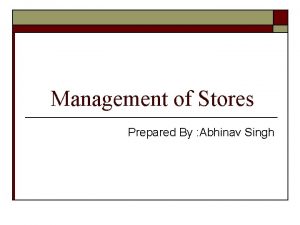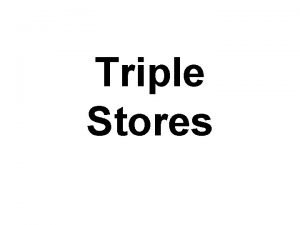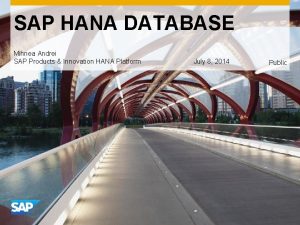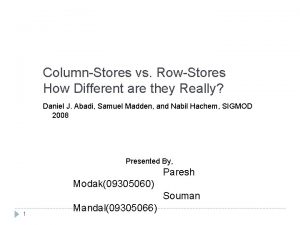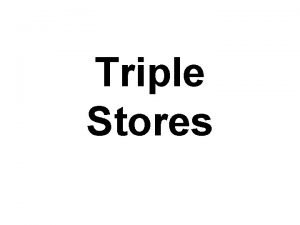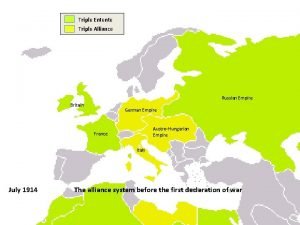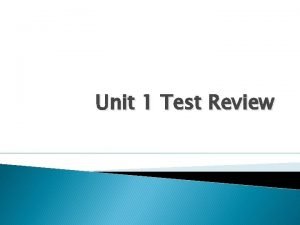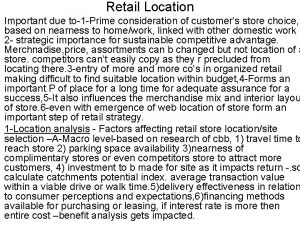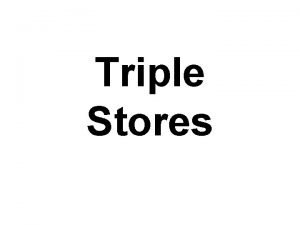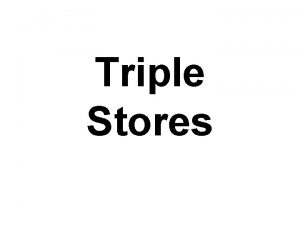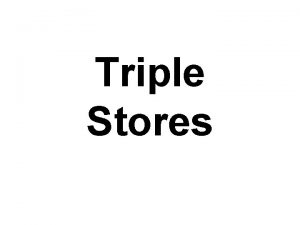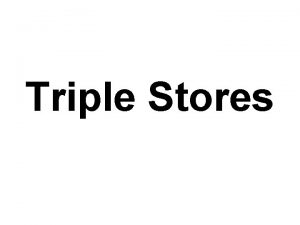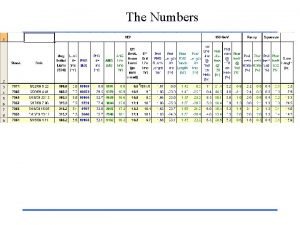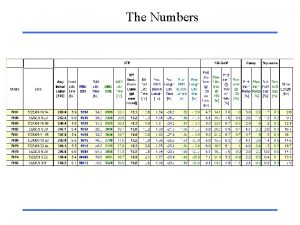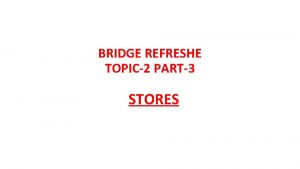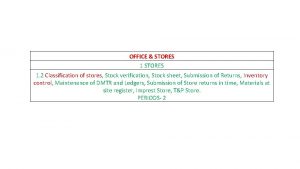Triple Stores What is a triple store l














- Slides: 14

Triple Stores

What is a triple store? l l l A specialized database for RDF triples Can ingest RDF in a variety of formats Supports a query language – – l l SPARQL is the W 3 C recommendation Other RDF query languages exist (e. g. , RDQL) Might or might not do inferencing Most query languages don’t handle inserts Triple stored in memory in a persistent backend Persistence provided by a relational DBMS (e. g. , my. SQL) or a custom DB for efficiency.

Architectures l Based on their implementation, can be divided into several broad categories : In-memory, Native store, Non-native store l In Memory : RDF Graph is stored as triples in main – memory l Native store: Persistent storage systems with their own implementation of databases. E, g. , JENA TDB, Sesame Native, Virtuoso, Allegro. Graph, Oracle 11 g l Non-Native store: Persistent storage systems set-up to run on third party DBs. Eg. Jena SDB using mysql or postgres

Architecture trade-offs l In memory is fastest, obviously, but load time has to be factored in l Native stores are fast, scalable, and popular now l Non-native stores may be better if you have a lot of updates and/or need good concurrency control l See the W 3 C page on large triple stores for some data on scaling for many stores

Large triple stores

Quads, Quints and Named Graphs l Many triple stores support quads for named graphs l A named graph is just an RDF with a URI name often called the context l Such a triple store divides its data a default graph and zero or more additional named graphs l SPARQL has support for named graphs l De facto standards exist for representing quad data, e. g. , n-quads and Tri. G (a turtle/N 3 variant) l Allegro. Graph stores quints (S, P, O, C, ID), the ID can be used to attach metadata to a triple

Example: Jena Framework l An open software Java system originally developed by HP (2002 -2009) – http: //incubator. apache. org/jena/ l Moved to Apache when HP Labs discontinued its Semantic Web research program ~2009 l Good tutorials – http: //incubator. apache. org/jena/getting_started/ l Has internal reasoners and can work with DIG compliant reasoners or Pellet. l Supports a Native API and SPARQL l Joseki is an add-on that provides a SPARQL

Jena Features l l l API for reading, processing and writing RDF data in XML, N-triples and Turtle formats; Ontology API for handling OWL and RDFS ontologies; Rule-based inference engine for reasoning with RDF and OWL data sources; Stores to allow large numbers of RDF triples to be efficiently stored on disk; Query engine compliant with the latest SPARQL specification Servers to allow RDF data to be published to other applications using a variety of protocols, including SPARQL

Example: Sesame l Sesame is an open source RDF framework with support for RDFS inferencing and querying l http: //www. openrdf. org/ l Implemented in Java l Query languages: Se. RQL, RDQL l Triples can be stored in memory, on disk, or in a RDBMS

Example: Stardog l http: //stardog. com/ by Clark and Parsia l Pure Java RDF database (“quad store”) l Designed to be lightweight and very fast for in memory stores l Performance for complex SPARQL queries l Reasoning support via Pellet for OWL DL and query rewriting for OWL 2 QL, EL & RL l Command line interface and JAVA API

Issues l Can we build efficient triple stores around conventional RDBMS technology? l What are the performance issues? – Load time? – Interfencing? l How well does is scale?

Performance l. A lot of work has been done on benchmarking triples stores l There are several standard benchmark sets l Two key things are measured include – – Time to load and index triples Time to answer various kinds of SPARQL queries l See, for example, recent (2011) data from the Berlin SPARQL Benchmarks which studied 4 store, Big. Data, Big. Owlim, TDB and Virtuoso.

Load Time

Queries per hour
 Centralized stores with sub-stores
Centralized stores with sub-stores What is a triple store
What is a triple store Row store vs column store
Row store vs column store Row store vs column store
Row store vs column store Triple store
Triple store Site:slidetodoc.com
Site:slidetodoc.com Triple alianza y triple entente
Triple alianza y triple entente Triple alliance ww1
Triple alliance ww1 антанта
антанта Triple entente vs triple alliance
Triple entente vs triple alliance Distinct threadlike structures contain genetic
Distinct threadlike structures contain genetic The arrangement of a phenomenon across earth's surface is
The arrangement of a phenomenon across earth's surface is Yf clothing
Yf clothing Inputs and outputs of drainage basin
Inputs and outputs of drainage basin For service and retail stores a prime factor
For service and retail stores a prime factor
